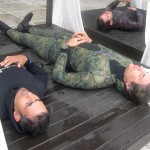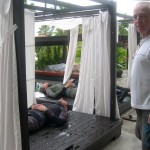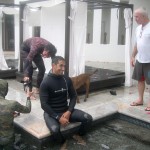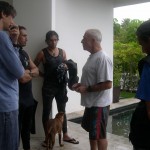The month was mainly spent in training four divers with different objectives, in different disciplines, for different competitions. As you see – a lot of differences, but I hope this will become clearer as the story is told.
The deepest diver was MT. Maria Teresa was preparing for the 3rd Mediterranean Cup in Greece, and then on to Okinawa 2010 in Japan with the UK team.
Her style with a monofin is excellent, rythm and pace were right, her breath hold was on target, her static, which is not her favourite occupation, was in the 6 min range. Her challenges were regularity. The demands of work and courses were the problem here and when there were consequetive days, sometimes the weather didn’t like us and there was always the third day tiredness factor, which we have always attributed to 2 factors – Nitric Oxide depletion and phsycological exhaustion. More is not always better! Rest is the most often ignored facet of training and it is vital, together with hydration.
However, her progression in depth was going exactly to schedule, the progression was systematic in small realisable units of 1 or maximum 2 mts. Each time the equalisation at the bottom was achieved -just !
She had put in a lot of work on mental training, normally people resort to this when there is already a problem. The correct approach is that it should be an integral part of the training from the begining, its initially being able to give yourself a command before the dive and then being able to execute it at the right time in the dive.
In the case of a beginner it might be “I must not look down on descent”, this is the begining of mental training, later it becomes taking control of the mind which involves knowing what commands to give and how to “frame” them. Later with the advanced diver (more than 60mts), when a lot has already been transferred to the automatic pilot and rythm of equalisation, timing of cheek fill, and entry into the glide are all automatic, then the art becomes one of finding the right focus, which passes from the needle point focus to the dispersed all encompassing focus, where everything just happens by itself without conscious effort. It is the Zen of diving.
Alina achieved this in her Israeli record dive of 38mts. Only 38mts! it could have been quite a bit more but the limitation was mine as this was her first competition and we wanted to get it right as she said it could have been an easy 40mt+. Alina has excellent monofin style and impressive will power.
For the 40mt diver one of the challenges is avoiding pressure “set points” ,every good trainer is familiar with this, it can even happen between 20-30 mts the diver descends without a depth guage on an unmarked line and stops at exactly the same depth every time. What is happening is the mind is confusing a feeling of pressure and the sensation of running out of air. The solution is first asking the diver to test if during the ascent the feeling of out of air persists or dissappears. In the advanced diver, more “empty lung” work is reccommended and later tables of head down descents in variable weights. Alina pre-empted this trap.
With Estrella – whose main discipline is no fins, the focus is, at first, on minute alterations of style to eliminate drag and maximise movement and to know exactly what amount of glide between each movement at what depth. She was a competition swimmer and has the physiological advantages of height and the build of an athelete that was formed at a very early age. Her understanding of style and how to adapt it for the under water is quick and intelligent. In her first week of training she passed the 4 min mark in static. Her challenge was in agreeing to the idea of systematic, incremental progress. She had a degree of impatience to explore the limits of her considerable potential, the trouble with this is you discover your limits, and they tend to become limits.
So time with Estrella is spent in counting movements to a certain depth and timing the distance covered. Discipline!
The group is completed by Manolo who is training for the Mexican National record in Static, he currently holds the male CNF and DNF records. He has an instinctive understanding of the axiom “you need stress to produce results, but stress does not produce results, adaptation to stress – does”. In here is the golden mean the right amount of stress and Manolo has an instinctive feeling for this.
It was a great group and I learnt a lot working with them .
Next we will be telling you about the competition the Cortez Challenge.
May
30
May
23
The story of this past month has been – a course for under water fishermen , training for 3 ladies
Maria Teresa preparing for the Mediterranean World Cup in Greece and The International competition in Okinawa , Alina Tsivkin’s preparation of 3 Israeli Records in CWT , FIM and DYN, and Estrella Navarro’s preparation of Mexican records in CNF, DNF and FIM. And finally the Spring Cortez Cup challenge.
THE FISHERMEN
This was a particularly nice group and very unlike most spearos . The basic trouble teaching spearos is because they are always vastly over weighted and are used to riding their weights to the bottom they have no idea of technique or even an idea that it might benefit them . They cant do a duck dive, their finning looks a lot like someone trying to ride a bicycle in a very tight miniskirt and believe it or not some have a lot of trouble equalising in a head down position . They all look down at the bottom when descending ,not realising that it is impossible to kick properly in this position – 80% back kick and 20% forward ,that it complicates equalisation and is in fact dangerous- incomplete irrigation of the brain.
Most of them have no idea of safety or of the dangers of their ignorance of this subject . My conclusion is that it is a miracle that any of them are still alive !! The main reason being that the majority are not 100ft men but fish in 6-7 mts. The contrast between them and their brothers in the Mediterranean is stark . In the Med . There are no fish worth taking between 30mts and the surface . The Mediterranean fishermen have long ago learned the benefits of adopting classic freedive techniques and learning a lot more about safety.
Perhaps the hardest thing to deal with is student deafness with this group you can be talking about the fact that there is little point in increasing there breath hold if they do not also improve
their aquacity where they are squandering all their gains in breath hold . All they hear is bla bla bla BREATH HOLD bla bla bla .
This group was exceptional in every respect ,especially in their lack of student deafness and their willingness to learn.
Giammarco is the owner of the best restaurant in Cabo San Lucas ,the Sunset Monalisa , it is both superbly situated facing the famous arch across the bay and has the informal quiet elegance of Italy.
Salvatore is the commander in chief of the kitchen and Carlos ,a professional photographer, is their fishing buddy .
They came with the expected fishermen’s faults but there the parallel stops , they learned and very fast .Their style improved ,both kicking and duck dive , as did head position and equalisation .
Their static breathold went to 4 mins and their dynamic and breath walk doubled . Breath walks of 1 min static and the 1:50 still holding were performed .
But the spirit of the group was inspiring in spite of some unusual hardships . Once getting chased out of the water by Humbolt squid ( see my former blog )and having to deal on more than one occasion with horrendous currents .All this paid off with DEPTH and more fish and I hope a much better understanding of safety.
My next blog will be following the trials and tribulations of a group of Elite freedivers their challenges and their training.The Mental aspects ,their progression in training , the questions that came up and the solutions we found together.
And then of course our Mini competition where a number of National records of 2 nations were broken .



